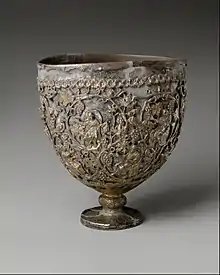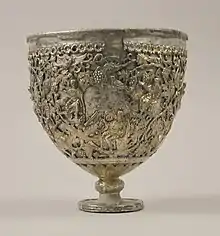Antioch chalice
The silver-gilt Antioch chalice was created around AD 500-550.[1] Currently it is on view at The Metropolitan Museum of Art Fifth Avenue in Gallery 300.[1] When it was discovered, the interior cup of the chalice was initially considered to be the Holy Chalice, the cup used by Christ at the Last Supper.[2][3] Recently, it has been concluded that it may have been a standing oil lamp and not a chalice.[2][4]


Description
The Antioch chalice is a silver cup that is encased within an elaborate open-work gilded silver footed shell.[5][6] It measures 19.6 x 18 x 15.2 cm with a 7.4 cm base.[1] The body of the cup, originally ovoid, has been bent out of shape.[7] When it was discovered, the chalice was covered in a heavy oxidation, which was cleaned off during the restoration process.[7] Internal corrosion has rendered the interior cup extremely brittle.[7] On the base of the chalice there are lotus petals, with a palm wreath above it on the bulb of the short stem.[8] Surrounding the rim of the shell is a row of rosettes and one star.[8] The bottom of the outer shell has an open lotus flower, and the upper areas of the outer shell contain a fruited grapevine wrought into twelve loops, each of the loops containing a figure.[1][8][5] Two of the figures portrayed in the loops are images of Christ, one showing Christ holding a scroll and the other showing Christ sitting beside a lamb, above a spread-winged eagle perched on a basket of fruit.[3][9][4] The other ten figures were initially thought to be ten of the apostles but they have been variably identified as classical age philosophers, who had foretold the coming of Christ.[1][9] On the outer shell there are also snails, doves, a butterfly, a grasshopper, and a rabbit.[8]
History
The Antioch chalice was found in Syria in 1910 along with several other items, including a large cross and three book covers.[7][2] It was believed to have belonged to a church in Antioch, one of the five cities that led the early Christian church along with Rome, Constantinople, Jerusalem, and Alexandria.[2] When it was discovered, the inner cup was thought to be the Holy Chalice, with the gilded, footed shell being added within the first century after the death of Christ to honor the grail.[2][9] It was displayed as the Holy Grail at the Chicago World's Fair in 1933 and was later sold to The Cloisters in New York in 1950.[10]
Recent events
Recently the Antioch chalice has been identified as having the shape of a standing lamp commonly used in churches in the first half of the sixth century.[1][2] Potentially, it is decorated in recognition of Christ's words "I am the light of the world".[9] It has also been determined recently that the Antioch chalice could have been a part of a larger group of silver objects that belonged to the Church of Saint Sergios in the small town of Kaper Koraon.[1][2]
References
- "The Antioch "Chalice" | Byzantine | The Met". The Metropolitan Museum of Art, i.e. The Met Museum. Retrieved 2017-11-21.
- Evans, Helen C.; Holcomb, Melanie; Hallman, Robert (2001). "The Arts of Byzantium". The Metropolitan Museum of Art Bulletin. 58 (4): 1–68. doi:10.2307/3269176. JSTOR 3269176.
- N.Y.), Metropolitan Museum of Art (New York (2012). The Metropolitan Museum of Art Guide. New York: The Metropolitan Museum of Art. ISBN 9780300179491. OCLC 836256531.
- N.Y.), Metropolitan Museum of Art (New York (1989). Europe in the Middle Ages. Little, Charles T., Husband, Timothy, 1945-. New York, N.Y.: The Museum. ISBN 0870994476. OCLC 14241505.
- Byzantium, 330-1453. Cormack, Robin., Vasilakē, Maria., Royal Academy of Arts (Great Britain). London: Royal Academy of Arts. 2008. ISBN 9781905711260. OCLC 227919169.
{{cite book}}: CS1 maint: others (link) - The liturgy of the medieval church. Matter, E. Ann., Heffernan, Thomas J., 1944- (2nd ed.). Kalamazoo, Mich.: Medieval Institute Publications. 2005. ISBN 1580440916. OCLC 56879994.
{{cite book}}: CS1 maint: others (link) - Arnason, H. Harvard (1941). "The History of the Chalice of Antioch". The Biblical Archaeologist. 4 (4): 49–64. doi:10.2307/3209152. JSTOR 3209152.
- Conway, Martin (1924). "The Antioch Chalice". The Burlington Magazine for Connoisseurs. 45 (258): 106–104. JSTOR 862294.
- Christine., Kondoleon (2000). Antioch : the lost ancient city. Princeton, N.J.: Princeton University Press. ISBN 0691049327. OCLC 43977990.
- Clarke, John R. (2003). "Finding Lost Antioch: Exhibition, Catalogue, Programs". The Art Bulletin. 85 (1): 185–188. doi:10.2307/3177332. JSTOR 3177332.